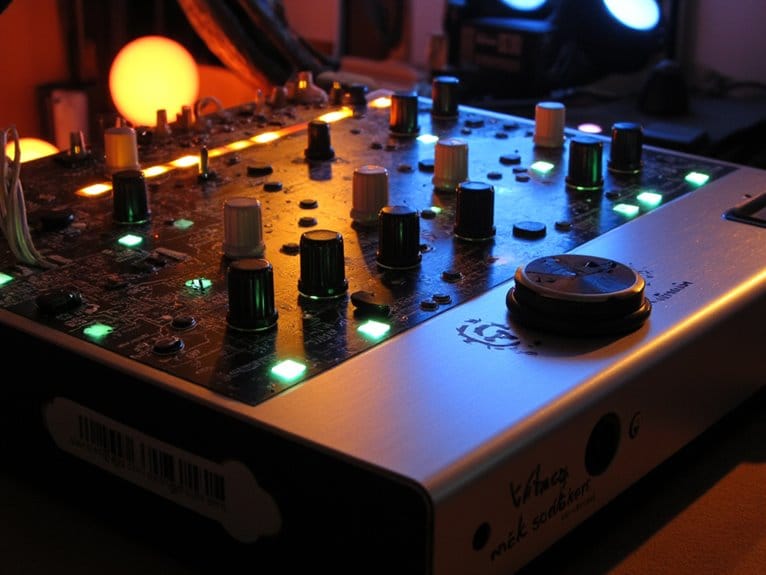Subtractive Synthesis: The Foundation of Electronic Music
You’ll find subtractive synthesis at the heart of nearly every electronic track you’ve ever heard, working by removing frequencies from harmonically rich waveforms like sawtooth and square waves using voltage-controlled filters. Starting with oscillators that generate raw sound material, you’ll sculpt tones through low-pass, high-pass, and band-pass filters, while ADSR envelopes control how sounds evolve over time. This efficient approach, pioneered by Robert Moog’s Minimoog in 1970, continues shaping modern electronic music production in ways that’ll surprise you. This technique has become more accessible over the decades, especially with the advent of software synthesizers and inexpensive synthesizer hardware. These developments have empowered countless artists to experiment with subtractive synthesis without breaking the bank. As a result, the soundscapes of contemporary music have expanded dramatically, incorporating elements that were once reserved for high-end studios.
We are supported by our audience. When you purchase through links on our site, we may earn an affiliate commission, at no extra cost for you. Learn more.
Notable Insights
- Subtractive synthesis creates sounds by filtering harmonically-rich waveforms, removing unwanted frequencies to sculpt desired timbres.
- The Minimoog’s 1970 release democratized subtractive synthesis, making electronic music creation accessible to mainstream musicians worldwide.
- Core components include oscillators generating raw sound, filters shaping frequency content, and envelopes controlling sound evolution over time.
- Unlike additive synthesis that builds complexity, subtractive synthesis starts rich and carves away frequencies for efficient sound design.
- Modern applications feature voice polyphony and LFO modulation, enabling complex layered compositions in contemporary electronic music production.
The Building Blocks: Oscillators, Filters, and Envelopes
The foundation of subtractive synthesis rests on three interconnected components that work together like a well-orchestrated team: oscillators generate the raw sonic material, filters sculpt and refine that material by removing unwanted frequencies, and envelopes control how these elements evolve over time to create dynamic, expressive sounds.
Three essential elements form subtractive synthesis: oscillators create raw sound, filters remove frequencies, and envelopes shape timing for expressive results.
When you’re working with oscillator waveforms, you’ll discover that sawtooth and square waves provide rich harmonic content, while sine waves offer pure tones for subtle textures.
Filter types like low-pass, high-pass, and band-pass each serve distinct purposes in shaping your sound’s character.
I’ve found that envelope shaping transforms static tones into expressive instruments through ADSR controls, while modulation techniques using LFOs add movement and life to otherwise predictable sounds, creating the foundation for compelling electronic music production.
Understanding the difference between analog and digital sound engines helps you choose the right synthesizer for your subtractive synthesis needs, as analog offers characteristic warmth while digital provides precise control. Modern electronic music production benefits from voice polyphony capabilities that allow multiple notes to be played simultaneously, with optimal ranges of 8-16 voices providing sufficient harmonic layering for complex compositions.
From Bell Labs to the Minimoog: A Historical Journey
While understanding these sonic building blocks gives you the tools to create compelling sounds today, the path that led to modern subtractive synthesis began in an unexpected place: the research laboratories of Bell Telephone.
Bell Labs’ digital innovation through Max Mathews’ MUSIC I in 1957 established computerized sound synthesis, while Hal Alles’ real-time digital synthesizer in the mid-1970s pioneered advanced audio experimentation with 32 sine-wave oscillators and intuitive human controls.
However, synthesizer evolution took a parallel track when Robert Moog’s analog Minimoog arrived in 1970, offering accessible subtractive synthesis that musicians could actually afford and understand.
This industry impact created the fundamental divide between experimental digital research and practical analog instruments, shaping electronic music’s future through voltage-controlled oscillators, filters, and envelopes.
Sculpting Sound: Creative Applications and Techniques
Once you’ve grasped the historical foundation of subtractive synthesis, you’ll discover that the real magic happens when you start sculpting sound through deliberate manipulation of oscillators, filters, and envelopes.
Your creative journey begins with selecting the right waveform-sawtooth for bright leads, triangle for smooth pads-then carving away frequencies with filters to reveal your desired timbre. Understanding proper signal flow ensures your sound travels efficiently from oscillators through filters to amplifiers, whether routing components in series for linear processing or splitting signals in parallel for complex layering effects.
Sound layering becomes powerful when you detune multiple oscillators slightly, creating thick, harmonically rich textures that cut through any mix.
Dynamic modulation transforms static sounds into living, breathing instruments through LFO-driven filter sweeps, velocity-sensitive envelope responses, and tempo-synchronized parameter changes that evolve with your music’s rhythmic pulse.
Subtractive vs. Other Synthesis Methods: Understanding the Differences
Understanding subtractive synthesis becomes clearer when you compare it to other synthesis methods, particularly additive synthesis, which takes a fundamentally opposite approach to sound creation.
While you’ll start with harmonically rich waveforms like sawtooth or square waves in subtractive synthesis, then sculpt your sound by removing frequencies through filtering, additive synthesis builds complexity by layering multiple sine waves at different frequencies and amplitudes.
The subtractive nuances involve voltage-controlled resonant filters and ADSR envelopes that shape your tone dynamically, whereas additive complexities require precise control over individual harmonic partials.
I’ve found that subtractive synthesis excels at creating warm, familiar tones quickly, while additive methods offer intricate timbre control that’s historically been more computation-intensive but increasingly accessible through modern digital technology.
On a final note
Now you’ve got the foundation to understand how subtractive synthesis shaped electronic music’s DNA, from those early Bell Labs experiments to your favorite synth tracks. You’ll recognize those filtered oscillators and punchy envelopes everywhere once you start listening critically. Whether you’re comparing it to FM or wavetable synthesis, you can’t deny subtractive’s raw immediacy and intuitive workflow. It’s still the most accessible entry point into synthesis, honestly. As you delve deeper into the world of sound design, you’ll find that a basic synthesizer categories overview can further clarify your understanding of subtractive synthesis alongside other methods. By exploring these categories, you’ll gain insights into how different synthesis techniques complement each other, enhancing your creative possibilities. This understanding will empower you to make informed choices when crafting your own unique sounds.




